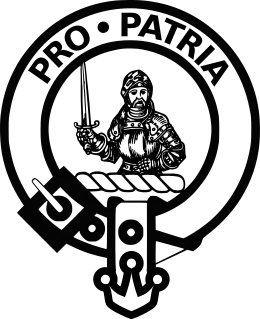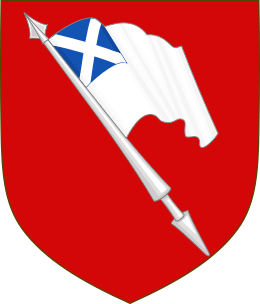Clan Bannerman facts for kids
Quick facts for kids Clan Bannerman |
|||
|---|---|---|---|
| Clann Mac a' Bhrataich | |||

Crest: A demi man in armour holding in his right hand a sword, Proper
|
|||
| Motto | Pro Patria ("For my Country") | ||
| Chief | |||
 |
|||
| Sir David Gordon Bannerman of Elsick | |||
| 15th Baronet of Elsick | |||
| Seat | Elsick House | ||
|
|||
|
|||
Clan Bannerman is a historic Scottish clan from the Lowlands of Scotland. Their name comes from a very special job: carrying the royal banner or flag. This important role has been part of their family history for a long time.
Contents
History of Clan Bannerman
How the Clan Began
The Story of the Banner Bearers
The Bannerman family name comes from their ancestors' special job. They were the ones who carried the king's royal flag, or "banner," hundreds of years ago. This was a great honor! The clan's coat of arms even shows this important role.
No one knows exactly when this tradition started. But one story says it was during the time of King Malcolm III of Scotland or King Alexander I of Scotland. The story tells of a time when the king bravely crossed the fast-flowing River Spey. Sir Alexander Carron, who was the king's chamberlain (a high-ranking official), carried the royal flag. The rest of the Scottish army followed him.
After a victory against rebels, King Alexander I rewarded Sir Alexander Carron. He made him the official, hereditary Standard Bearer to the King. This meant his family would always have this special job. His descendants, the Bannermans, still hold this privilege today.
Early Records of the Clan
We have records showing the Bannermans were important in Scotland by the 1300s. In 1367, King David II of Scotland gave Donald Bannerman some lands. These lands were Clyntrees, Waterton, and Weltown in Ellon, Aberdeenshire.
As part of this gift, the Bannermans had to build a chapel. In this chapel, a weekly church service was held to honor King David II's father, King Robert the Bruce. A few years later, in 1370, the Abbot of Kinloss also gave land to the Bannermans. This land was located west of the city of Aberdeen.
The 1500s and 1600s
The Bannermans became involved in the politics of northeast Scotland. This included taking sides in a big rivalry between two powerful clans: Clan Gordon and Clan Forbes. The Bannermans usually supported the Forbes family.
However, in 1608, Margaret Bannerman married George Gordon of Haddo. George Gordon was a strong supporter of the king. He later faced serious consequences for opposing the National Covenant, a religious and political movement.
Alexander Bannerman also supported King Charles I of England during the Scottish Civil War. He was against the Scottish Presbyterians. His family's lands were almost taken away. But they were saved by being passed to his brother-in-law, Sir George Hamilton.
In 1644, Alexander Bannerman had a serious conflict with his cousin, Sir George Gordon of Haddo. Gordon was injured during this event. Eventually, the family lands were given back to Alexander Bannerman's son, also named Alexander Bannerman. This Alexander Bannerman of Elsick was given a special title by King Charles II of England. On December 28, 1682, he was made a Baronet of Nova Scotia. This was a reward for his strong loyalty during the civil war.
The 1700s and Jacobite Risings
The Bannermans continued to be involved in Scottish history. Alexander Bannerman's youngest son, Sir Patrick, supported the Stuart kings who had lost their throne. This was during the Jacobite rising of 1715. Sir Patrick was the Provost of Aberdeen, a leader of the town. He welcomed James Francis Edward Stuart (also known as the Old Pretender) to Scotland. James then made Sir Patrick a knight.
After the rising failed, Sir Patrick was arrested. He was taken to Carlisle as a prisoner. He was supposed to be executed, but he managed to escape to France.
During the Jacobite rising of 1745, another Bannerman, Sir Alexander Bannerman, joined Prince Charles Edward Stuart. He brought 160 men from the clan to Stirling in 1745. He was also with the Prince when he escaped after the difficult Battle of Culloden in 1746. Bannerman fled north to Dingwall and then to Sutherland. He later escaped to France. He narrowly avoided government troops by hiding in a secret room at Elsick House.
Because of the threat of losing their lands and suspicions of Jacobite activities, Sir Alexander Bannerman, the fourth Baronet, had to sell the Elsick estates.
Modern Clan History
The Bannerman name has continued to be important in recent times.
Henry Campbell-Bannerman was the Prime Minister of the United Kingdom from 1905 to 1908. He took the name Bannerman from his mother in 1868. He quickly rose through government ranks. He became a close friend of King Edward VII, who later made him Prime Minister.
Sir Arthur Bannerman, the twelfth Baronet, served in the Indian Army. From 1921 to 1928, he was an important advisor to the Secretary of State for India. He also served as a Gentleman Usher to three kings: George V, Edward VIII, and George VI. He received a high honor, being made a Knight Commander of the Royal Victorian Order in 1928.
John Bannerman, Baron Bannerman of Kildonan was a famous Scottish rugby player. He played for his country 39 times.
The thirteenth Baronet served in the Cameron Highlanders, a famous Scottish regiment. He also became an expert in the Russian language.
Clan Chief Today
The current Chief of Clan Bannerman is Sir David Gordon Bannerman of Elsick. He is the 15th Baronet and holds an OBE honor.
Sir David went to Gordonstoun School and New College Oxford. He lives in Suffolk, England. He has four children: Claire (born 1961), Margot (born 1962), Arabella (born 1965), and Clodagh (born 1975). He also has seven grandchildren.

